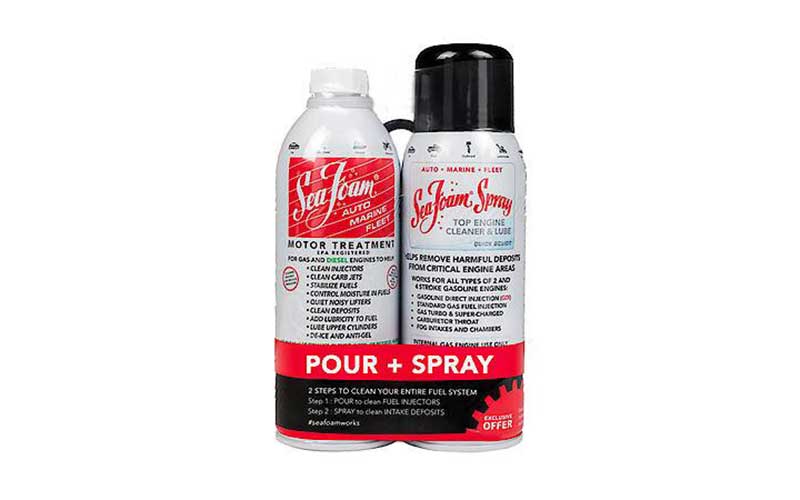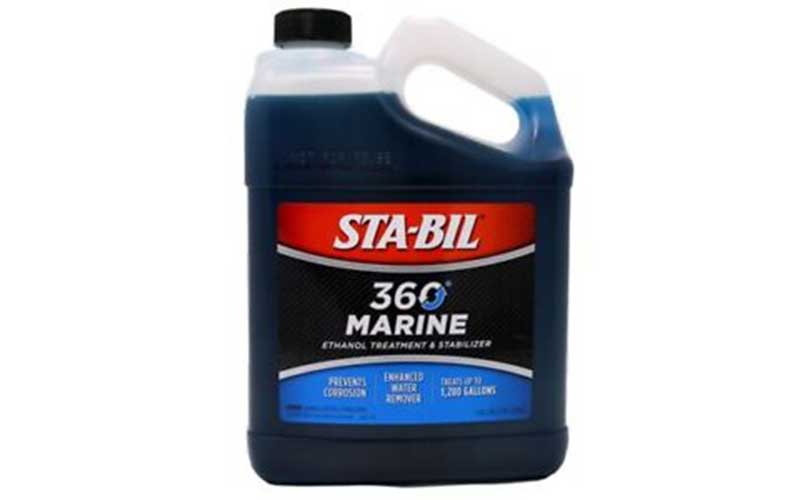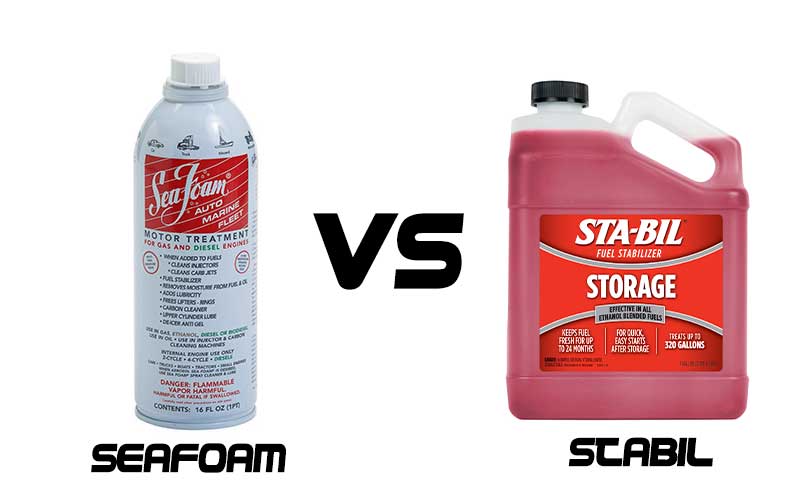Often, vehicle owners are left unsure about the gasoline stabilizer to choose because of their different strengths and applications. When the topic of high-quality gasoline stabilizers is brought up, Seafoam vs STABIL appears to be engaged in a never-ending battle.
Do you want to know which is best for your engine? Which stabilizer would increase your engine’s lifespan?
Before deciding which is superior, we must first comprehend both before drawing comparisons between them. The first thing we need to do is familiarize ourselves with their technical details and other attributes.
In this article, we’ll specifically do that, considering every needed detail to satisfy your curiosity.
So, relax and read up.
Is Sea Foam better than Stabil?
Seafoam and Stabil Storage are designed to preserve your vehicle fuel in the best state for at least 2 years. Nonetheless, Seafoam is twice the cost of Stabil Storage. On the other note, Stabil Storage has a potency two and a half times more than Seafoam.
When you turn off a car’s engine for a prolonged period, it can get “grounded” forever, much like other machines. This is because the ordinary fuel used to power your car only has a three- to six-month shelf life.
After that, the engine may suffer damage as a result of the fuel being kept in storage after its expiration date and potentially spoiling and becoming gummed up.
Due to this, it’s important to choose a good engine cleaner & fuel stabilizer that can make your car’s fuel clean and maintain it for a prolonged period while also cleaning the engine & fuel system as a whole.
Two high-end gasoline stabilizers, Seafoam & STABIL, can increase engine lifespan by preventing gum, varnish, and other irritants from building up on the surfaces of the engine.
Overview of Seafoam and Stabil Seafoam Motor Treatment
For vehicle owners, having Seafoam Motor Treatment on hand is a tremendous asset. It may be utilized with any engine type, including those in conventional gasoline, diesel, & alternative fuel cars.
Using it is simple as well! You just need to pour the substance into your crankcase or tank until there is no more room, let it sit for about 10 minutes, then wash or rinse it off with clean water.
Additionally, Sea Foam SF-16-2PK Motor Treatment is an organic remedy that helps in preventing engine/motor wear. It lubricates the engine, removes carbon deposits, and boosts horsepower.
Customers who have used Sea Foam SF-16-2PK Motor Treatment have claimed improved gas mileage, more horsepower, quieter motors, & smoother running motors/engines. To restore your car’s engine performance, this product should be applied every two years or as required.
Designed to safeguard the entire fuel system, seafoam is a kind of petroleum-based lube/lubricant. The main purpose of the lube is to avoid wear and corrosion by keeping the top cylinders from getting dry & rusty.
Additionally, seafoam has a chain lubricate feature that facilitates easy engine operation by assisting in the free movement of valves, rings, connecting rods, and crankshafts.
The seafoam is a fantastic alternative for individuals who wish to make their engines clean without using abrasives or harsh detergents that could damage their engines.
For years, expert mechanics have used it as an all-natural method to clean muck and build-up from cars because it only contains petroleum-based substances.
Also Read: Power Steering Fluid Colors and What They Mean (Ultimate Guide)
Pros and Cons of Seafoam

Pros
- Fuel is stabilized for about two years.
- Offers improved fuel efficiency.
- Sanitizes the engine chambers. Avoids typical engine issues.
- Injector & carburetor cleaning
- removes impurities from crankcase oil.
- Fit for a variety of gasoline and diesel mixtures.
- Easy to utilize, and it’s safe.
Cons
- There is little to no corrosion protection.
- It could lessen oil viscosity.
- GDI engines shouldn’t use this.
- The oxygen sensor might be harmed.
STA-BIL Storage Fuel Stabilizer
Larger fuel tanks have always been an issue for a lot of people, especially over the winter when they aren’t driving their cars as much. Storage with STA-BIL Gasoline and other fuels can have their life span extended with the aid of a fuel stabilizer like Fuel Stabilizer.
This is accomplished by combating sediment, corrosion, sediment build-up, gum and varnish deposits. It also stops fuel from spoiling. For fuel or gasoline that will be kept in storage or fuel tanks for at least six months, an STA-BIL Storage gasoline Stabilizer should be added.
Storage with STA-BIL Gasoline Stabilizer guarantees you constantly have gasoline when you require it, in addition to assisting your fuel in maintaining its quality.
Instead of draining your storage or fuel tank and filling it up with new gasoline as you would do with any other product, you won’t need to do so if you use STABIL Storage Fuel Stabilizer.
Because water is present in gasoline, the hydrocarbon molecules that are components of the fuel are kept apart by a scientific formulation.
The need for filtering and stabilizing fuel to make sure the gas has the longest possible shelf life is sometimes overlooked. When fuel is produced, it may become contaminated if water or any other substance is added.
Use a fuel stabilizer to maintain the smooth operation of your tank! Making use of the STA-BIL Storage stabilizer to stop corrosion, rust, gum, and varnish in your fuel tank will help you save money in the long run.
STA-BIL Storage, a fuel stabilizer, is suited for use in all fuel vehicles, including two-cycle types. This procedure has been proven to be safe for use in fuel engines and to help maintain gasoline quality for about one year after the procedure is completed.
With the following instructions, this product will enable your car to run better and perform better.
Also Read: Can You Use Power Steering Fluid as Brake Fluid?
Pros and Cons of STABIL

Pros
- Stabilizes gasoline for about two years, and fuel efficiency is increased.
- Makes the carburetor and injector clean.
- Safeguards against engine and fuel tank rust.
- Keeps sludge and varnish from forming.
A broad range of applications in fuel engines.
- Compatible with both non-ethanol and ethanol gasoline.
Cons
- Diesel engines cannot use it.
- There is a finite life span.
Seafoam vs STA-BIL Comparison
The use, efficacy, and price of Seafoam & STA-BIL are the most crucial factors to take into account. While STA-BIL and Seafoam are both intended to safeguard your engine, their mechanisms are distinct.
You may choose which gasoline additives are better for your car’s engine by comparing Seafoam and STA-BIL in the table below.
Performance
The seafoam is better renowned for cleaning engines since it primarily targets carbon build-up in the engine’s fuel system, including the carburetor jets, passageways, and fuel injectors. As you can as well add seafoam to the crankcase, which contains motor oil, it is incredibly effective at removing sticky resins and sludge from motors.
People further assert that seafoam is only effective for automobiles with higher mileage and that it is only marginally effective for vehicles with lesser usage and, hence, no carbon build-ups.
Because seafoam includes 40–60% heavy pale oil, which will smoke regardless of the circumstances, it also dissolves the engine deposits while producing a significant amount of smoke from the engine.
Contrarily, when consumers leave their engines idle for extended periods, they like to use STA-BIL as a fuel stabilizer to prevent gasoline or fuel separation.
STA-BIL is alcohol-free in contrast to seafoam. As they are the exclusive components of the brand, the business has not disclosed the precise components that went into the creation of STA-BIL.
STA-BIL is an isoparaffinic hydrotreated solvent that contains mineral oil, petroleum distillates, heavy naphtha, & low-odor cleaning solvent, according to the people’s experiments. It is yet unknown what percentage of various compounds is in STA-BIL.
After adding STA-BIL to your gasoline, it separates & forms a thin coating on top of the fuel to keep out air &, more importantly moisture.
Usage
The use of seafoam in the fuel/gas tank is secure if you’re using ethanol-free fuel. For tiny engines, a gallon of fuel and 1 oz of seafoam is good.
For improved performance, you can operate the engine with 1/3 of the throttle open & 2/3 full. To ensure that it is secure to pour into the fuel tank, the seafoam also contains an octane booster and fuel stabilizer (Naphtha). Use a small amount of seafoam oil before changing the oil if it’s possible to do so.
To remove crud, debris, etc., from your system, let the motor/engine run while the seafoam is circulated. The next time you drive, make sure you change your oil. After making use of seafoam in your crankcase, you should change your oil since the significant quantity of built-up debris that the Seafoam removes can obstruct your oil flow.
It’s a common misconception that Seafoam aids with fuel water removal. This isn’t accurate. Because alcohol is hydrophilic, it draws water to itself.
Water is drawn to the isopropyl alcohol in seafoam, which has between 10 and 20 percent of it when added to gasoline that has become tainted with water. Water is dragged into the combustion process by the alcohol because it is bound with the alcohol; as a result, steam is released.
STA-BIL stabilizers are available in two different types; Regular STA-BIL and STA-BIL 360. Every 10 gallons of fuel should have 1 oz of STA-BIL 360, and every 2½ gallons of gasoline/fuel should contain 1 oz of ordinary STA-BIL.
In contrast to seafoam, you shouldn’t add STA-BIL through the air throttle channel, vacuum lines, or crankcase. Only fill the fuel tank with STA-BIL. If you add seafoam to the air intake, be careful because the exhaust will emit harmless white smoke plumes.
Make use of STA-BIL only in the authorized dosage if your tank contains E10 gasoline, which contains ethanol. It can be problematic to add more. Rubber & plastic components in the carburetor may become damaged if seafoam is used with E10 fuel.
Effective Duration to Stabilize Fuel
For three to six months, regular gasoline remains fresh. The choice between STA-BIL &
Seam for keeping the fuel fresh for an extended period is therefore important. According to STA-BIL Marine & STA-BIL Regular, the fuel will remain stabilized for about two years and another one year, respectively.
The Seafoam website claims that seafoam will lubricate fuel, enhance lubricity, & stabilize gasoline for about two years while cleaning carburetors, fuel injectors, carbon, gum, & varnish deposits.
Why Do We Need Fuel Stabilizers?
Gasoline’s instability and propensity for oxidation are its key drawbacks. This could cause food to go bad, turn rancid, lose flavor, smell unpleasant, turn brown, and get dirty and polluted.
The usage of a gasoline stabilizer is a method for storing fuel for an extended period. By removing oxygen from the atmosphere, neutralizing acids, & lowering volatility, stabilizers stop oxidation. Additionally, they lower the risk of fire and stop the accumulation of dirt and debris. You can either purchase them from any nearby retailer or mix them with fuel at the petrol station.
Also Read: Transmission Fluid Leak (Causes & Solution)
Frequently Asked Questions – Seafoam vs STABIL
How long does it take for Sea Foam to work in a gas tank?
A full Sea Foam can be added to a low gasoline tank for optimum benefits. Before refueling, let your truck run for a minimum of 20 miles after adding SeaFoam to the gasoline tank. You can prevent the Sea Foam from being diluted further by adding more fuel, so it will have time to pass through the fuel system.
Can I put Sea Foam in a full gas tank?
Yes, you can use Sea Foam Motor Treatment with ANY gasoline/diesel fuel mixture. It’s always safe, simple to use, and does an excellent job of cleaning the fuel system in your engine.
How long does Stabil last in gas?
For about two years during storage, fuel stabilizers keep gasoline functional and fresh. After more than three months of storage, liquid fuels may become less probable to ignite correctly in an engine due to chemical processes occurring within the fuel and the evaporation of some volatile components.
Will STA-BIL fix old gas?
No additive will revive old gasoline. The best that can be hoped for is that the addition of a stabilizer to the old gasoline will stop it from degrading further. Petroleum Distillates are the principal constituent according to the Sta-Bil MSDS. Fuel distillates such as kerosene and gasoline are regarded as such.
Which is a better fuel stabilizer Stabil or Sea Foam?
Seafoam vs. stabil: Which is superior? Keeping gasoline in nice condition for about 24 months is possible with both Stabil Storage and Sea Foam. The overall value of Stabil Storage, which is 2½ times more powerful and costs half the price of seafoam, is significantly better.
Is it better to drain the gas or use a stabilizer?
Alternative: Use a gas stabilizer to reduce dangers. The worst thing you can do is leave old gasoline in a motor/engine for prolonged storage; thus, manufacturers occasionally advise draining the tank when preparing a lawn mower for the winter.
How often should you use a fuel stabilizer?
Most of the time, gasoline only needs to be stabilized if it won’t be used up in 2 months (but carbureted bikes should still be run every couple of weeks, as stated above). Old gasoline won’t be renewed by adding a bit of fresh stabilizer or gas, and old stabilized gasoline won’t have its usable life extended by adding an extra stabilizer.
Does STA BIL fuel stabilizer go bad?
Since its exposure to oxygen has been constrained in a factory-sealed container when it is kept in a cool, dry environment, an unopened bottle of STA-BIL® Fuel Stabilizer will stay viable on the market for around two years.
Does premium gas last longer in storage?
Unfortunately, there isn’t anything in premium fuel that would enable it last longer compared to other fuels at the pump. Because the higher octane levels are what set them apart, the only true advantage you receive is a reduced risk of engine/motor knocking, which doesn’t pose a significant risk on the majority of contemporary fuel systems.
Conclusion - Seafoam vs STABIL
Fuel stabilizers are important, and that is without a doubt. It is important to use the fuel/gasoline stabilizer brand that is best for the engine in your automobile, though. It’s worth reflecting on STA-BIL vs. seafoam. But among the various fuel stabilizer manufacturers, STA-BIL is regarded as the best overall.
Since 1 oz of STA-BIL can support 2½ gallons of gasoline/fuel as opposed to 1 oz of seafoam for one gallon of gasoline/fuel, it is less expensive and more efficient. STA-BIL is twice as expensive as seafoam. Therefore, before making a purchase, make sure to take into account your budget as well as every aspect that sets these two apart.

